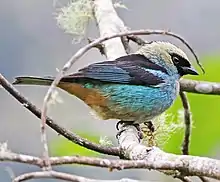| Metallic-green tanager | |
|---|---|
 | |
| Northwestern Ecuador | |
| Scientific classification | |
| Domain: | Eukaryota |
| Kingdom: | Animalia |
| Phylum: | Chordata |
| Class: | Aves |
| Order: | Passeriformes |
| Family: | Thraupidae |
| Genus: | Tangara |
| Species: | T. labradorides |
| Binomial name | |
| Tangara labradorides (Boissonneau, 1840) | |
 | |
The metallic-green tanager (Tangara labradorides) is a species of bird in the family Thraupidae. It is found in Colombia, Ecuador, and Peru. Its natural habitat is subtropical or tropical moist montane forests.
Taxonomy and systematics
The blue-and-black tanager was first described as Tanagra (Aglaia) labradorides by Auguste Boissonneau in 1840 on the basis of a specimen from Santa Fe, Colombia.[2] The generic name Tangara comes from the Tupí word tangara, meaning dancer. The specific name labradorides is from the French pierre de Labrador (feldspar), and the Ancient Greek -ides, meaning resembling, referring to the species' metallic blue-green color, which resembles that of feldspar.[3] Metallic-green tanager is the official common name designated by the International Ornithologists' Union (IOC).[4]
The metallic-green tanager is one of 27 species in the genus Tangara. It was previously thought to form a species group with the blue-browed and golden-naped tanagers. However, phylogenetic studies have shown that the golden-naped tanager is only distantly related to the other two species in the group. Its relation with the blue-browed tanager is also unclear, as some studies have shown the metallic-green tanager to be sister to the blue-browed tanager, but others have found this grouping to be paraphyletic.[5][6][7]
Subspecies
There are two recognized subspecies of the metallic-green tanager.[4] DNA studies have shown that the rate of divergence between in nucleotide sequences between the two subspecies is higher than that of several other tanagers currently recognized as distinct species.[5][6]
- T. l. labradorides (Boissonneau, 1840): The nominate subspecies, it is found in western and central Colombia and western Ecuador.
- T. l. chaupensis Chapman, 1925: Found from southeastern Ecuador and northern Peru. It is similar to the nominate, but is greener in color, with a paler abdomen, no gold on the forehead, and golden-green margins on the primary flight feathers.[5]
Gallery
 Painting of metallic-green tanager (below) with a golden-naped tanager (above)
Painting of metallic-green tanager (below) with a golden-naped tanager (above).jpg.webp) A metallic-green tanager eating fruit.
A metallic-green tanager eating fruit.
References
- ↑ BirdLife International (2018). "Tangara labradorides". IUCN Red List of Threatened Species. 2018: e.T22722909A132159585. doi:10.2305/IUCN.UK.2018-2.RLTS.T22722909A132159585.en. Retrieved 13 November 2021.
- ↑ Société Cuvierienne; Cuvierienne, Société (1840). Revue zoologique (in French). Paris: Société cuvierienne. p. 67.
- ↑ Jobling, James A. (2010). Helm Dictionary of Scientific Bird Names. Christopher Helm. pp. 217, 379. ISBN 978-1-4081-3326-2.
- 1 2 "Tanagers and allies – IOC World Bird List". Retrieved 2021-09-07.
- 1 2 3 House, Ryan; Burns, Kevin J. (2020-03-04), Billerman, Shawn M.; Keeney, Brooke K.; Rodewald, Paul G.; Schulenberg, Thomas S. (eds.), "Metallic-green Tanager (Tangara labradorides)", Birds of the World, Cornell Lab of Ornithology, doi:10.2173/bow.megtan1.01, retrieved 2021-10-29
- 1 2 Burns, Kevin J; Naoki, Kazuya (2004). "Molecular phylogenetics and biogeography of Neotropical tanagers in the genus Tangara". Molecular Phylogenetics and Evolution. 32 (3): 838–854. doi:10.1016/j.ympev.2004.02.013. PMID 15288060.
- ↑ Sedano, Raul E.; Burns, Kevin J. (2010-01-19). "Are the Northern Andes a species pump for Neotropical birds? Phylogenetics and biogeography of a clade of Neotropical tanagers (Aves: Thraupini)". Journal of Biogeography. 37 (2): 325–343. doi:10.1111/j.1365-2699.2009.02200.x. S2CID 53063036.
